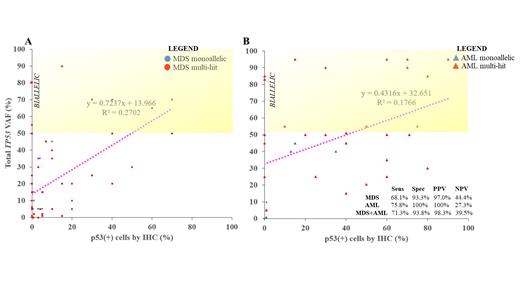Background: Myelodysplastic neoplasms (MDS) and acute myeloid leukemia (AML) are heterogeneous diseases that often carry a poor prognosis. Once MDS or AML is diagnosed, first-line therapy choices include hypomethylating agent/venetoclax, induction chemotherapy, and/or targeted therapeutics as appropriate. Traditional “7+3” induction therapy has limited efficacy in in patients with TP53 disruption. Mutations in TP53 occur in at least 8% of de novo AML genomes, but turnaround time for next-generation sequencing (NGS) can be 10-14 days. Hence, it is possible that patients with TP53 mutation(s) will receive a regimen that will not be effective as it will not be known whether a patient has a TP53 mutation soon after diagnosis. Furthermore, health care disparities are amplified by the lack of readily available precision diagnostics in low- and middle-income countries (LMIC), leading to worse outcomes. Early identification of TP53 mutation through p53 immunohistochemistry (IHC) testing might allow for more timely prognostication and intervention.
Methods: The UMass Chan Leukemia Registry and UMass Hematopathology archives identified patients with MDS or AML with TP53 disruption between 2011 and 2023. Immunohistochemical staining for p53 was performed on sections of bone marrow core biopsies by VENTANA CONFIRM anti-p53 (DO-7) primary antibody. Images were scored by manual counting by at least 2 separate hematopathologists. TP53 mutational analysis was performed as previously described (Patel SA , ..., Gerber JM. Leuk Lymphoma 2021; 62: 3348-60). For TP53 exome sequencing, the entire coding region from codons 1-393 of isoform A were covered, with coverage depth > 500X. The concordance between p53 IHC and the referent test ( TP53 mutational testing as the gold standard) was assessed.
Results: Query of theUMass Leukemia Registry and UMass Hematopathology archives yielded 86 clinically annotated patients with MDS and AML with TP53 disruption. Among 42 patients with MDS (or its subentities) with TP53 disruption, 61 bone marrow biopsies had concurrently available data for p53 IHC and TP53 mutational testing. (Some cases were sequential biopsies from the same patient). Among 44 patients with AML (or its subentities) with TP53 disruption, 36 bone marrow biopsies had concurrently available data for p53 IHC and TP53 mutational testing. For patients with MDS with TP53 disruption, the sensitivity of p53 IHC testing was 68.1% and specificity was 93.3% (Panel A). For patients with AML with TP53 disruption, the sensitivity of p53 IHC testing was 75.8% and specificity was 100% (Panel B). Merged MDS and AML analysis showed sensitivity of 71.3% and specificity of 93.8%. When using a cutoff of ≥ 5% for p53 IHC testing, positive predictive value (PPV) was 100%.
Conclusion: Our data show that p53 IHC testingdemonstrates high specificity and PPV but low sensitivity and negative predictive value (NPV), suggesting that IHC may be a valuable “rule-in” test. A cutoff value of ≥ 5% for IHC confers 100% PPV. This suggests that a positive IHC result may justify p53 IHC-adapted first-line choice of therapy, but a negative result does not exclude the possibility of TP53 mutation. IHC testing is a more cost-effective measure and is more readily available than NGS, which would make it an attractive alternative especially across global markets and in geographic regions marked by health care inequities, due to inability to access genomic testing. Limitations to our study include the relatively small sample size, as well as presence of TP53 mutations that prevent protein expression and thus prevent IHC positivity (i.e. stop codons and/or post-transcriptional modifications). Furthermore, results from our study may be distinct from other centers' studies given different inclusion criteria and non-uniform criteria for p53 staining analysis. However, our study retains value in that the use of a high-fidelity point-of-care p53 IHC staining method may lead to better outcomes with reduced financial toxicity and may inform first-line therapeutics if the IHC is positive. Further large-scale studies will be needed to confidently establish the p53 IHC staining method as the preferred surrogate for TP53 mutational testing. Additional work needs to be performed to assess the link between p53 staining pattern and TP53 allelic state. Earlier precision treatment may improve outcomes in this exceptionally high-risk population.
Disclosures
Patel:Pfizer: Consultancy, Honoraria, Membership on an entity's Board of Directors or advisory committees; UMass Center for Clinical and Translational Science (CCTS) Pilot Project Program grant (NIH / NCATS Grant UL1TR001453: Research Funding; Bristol Myers Squibb: Consultancy, Honoraria, Membership on an entity's Board of Directors or advisory committees. Cerny:Viridian Therapeutics: Current holder of stock options in a privately-held company; 2Seventy Bio Reg SHS: Current holder of stock options in a privately-held company; Vaxart Inc: Current holder of stock options in a privately-held company; Veru Inc: Current holder of stock options in a privately-held company; Sorreto Therapeutics: Current holder of stock options in a privately-held company; Ovid Therapeutics Inc: Current holder of stock options in a privately-held company; Novavax Inc: Current holder of stock options in a privately-held company; Atyr Pharma: Current holder of stock options in a privately-held company; Gamida Cell: Current holder of stock options in a privately-held company; Dynavax Technologies: Current holder of stock options in a privately-held company; Cellectar Sciences: Current holder of stock options in a privately-held company; BlueBird Bio, Inc: Current holder of stock options in a privately-held company; Actinium Pharmaceuticals: Current holder of stock options in a privately-held company; MERIT CRO: Consultancy, Honoraria, Membership on an entity's Board of Directors or advisory committees; Bristol Myers Squibb: Consultancy, Honoraria, Membership on an entity's Board of Directors or advisory committees; ICON- Prolacta: Consultancy, Honoraria, Membership on an entity's Board of Directors or advisory committees; ICON- Allovir: Consultancy, Honoraria, Membership on an entity's Board of Directors or advisory committees. Gerber:Bristol Myers Squibb: Research Funding; Hutchmed: Research Funding; Novartis: Honoraria, Research Funding; Stemline Therapeutics, Inc.: Research Funding; AbbVie: Divested equity in a private or publicly-traded company in the past 24 months.


This feature is available to Subscribers Only
Sign In or Create an Account Close Modal